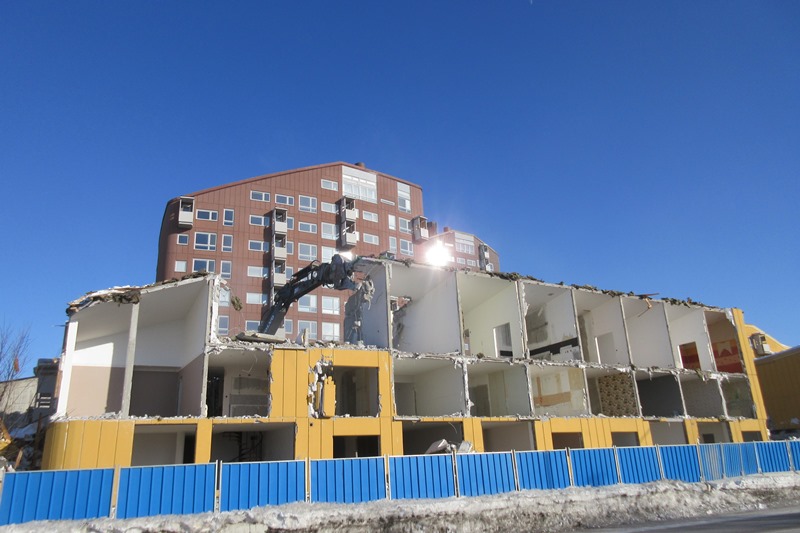There was no cheering in Kiruna when the Berlin Wall started to come down a few days ago. Every few minutes a lone car took a slow tour round the town square, its occupants craning their necks to watch the destruction, pausing briefly in a show of respect before driving off again.
A group of buildings, providing mainly flats, were put up in central Kiruna in the 60s in the belief that old buildings were an embarrassment and high rise flats indicated forward-thinking modernity. They were designed by the Scottish-born architect Ralph Erskine. Erskine wanted to create buildings that really encouraged communities to form and bond by the way the buildings related to one another. In the end he had to alter his designs because the council was more concerned about costs than community, but a few traces of Erskine’s idealism remained – some public areas and a small church. The buildings huddle together along a southern slope of town, soaking up the winter sun, an odd mix of low and high rise, in gentle shades of orange and dark brown. Their warm-looking rounded shapes have stark metal balconies designed to look like old mine person transport cages, which seems hardly something you’d want to have outside your flat but clearly appealed to Erskine. The buildings were immediately given the rather derogatory nicknames of Snusdosan, Spottkoppen, and Berlinmuren (the Berlin Wall) because they weren’t popular with the locals. Perfectly good old buildings had been knocked down to make way for them, and the locals were sorry to lose those old buildings. Now, after only 60 years, their time too had come. The Berlin Wall was coming down.
The buildings may have been unpopular but over time they became iconic for Kiruna, an outline above the town indicating that this town hadn’t stood still, that old and new were blending here because of the prosperity brought by the mine. There wasn’t always prosperity though, and there were times when Kiruna had many more flats than it needed. Erskine’s other big project – in Svappavaara, a town 50 km away – was a larger block of flats, nicknamed ‘the long snake’, and only 13 years ago these were partly knocked down simply because they were empty and weren’t needed. Since then Svappavaara has had to build more flats – times change fast. Kiruna’s Erskine buildings survived that same fallow period, only to be knocked down now – not because of bad times, but because of good – the mine’s fortunes so assured they can afford to destroy a whole town and build it again down the road.
On the first day of the destruction some people climbed up snow piles to get a better view. Others used drones to take photos. In the old, partly fenced-off town square people sat in their cars and stared, or got out to look, just to know it was real. Groups gathered to watch, knowing they were witnessing a significant event, one to be recorded in the memory bank of the whole family. Parents with young children in pushchairs gazed up at the violence so close in front of them, as if they were in the front row watching a blockbuster disaster movie. Bursts of loud crashing and crunching noise and clouds of dust would have reminded them that this was the real thing.
Machinery with giant bird-like, corrugated beaks was eating into the concrete and crashing its way through walls, biting off cables and then delicately depositing bits in piles beneath them. The demolition company could have just blown the building up, but it was positioned on one of Kiruna’s main roads so I guess there was a need to limit the spread of debris. Also, this way was slower, and maybe the mining company understood that we needed time to say goodbye, to witness the gradual dismantling of our memories, not just wake up one morning to a pile of rubble. Even so, even though they chose the careful slow method, it took only three days for the building to disappear and the hole it left seemed sudden.
We know the demolition will continue and we’ll be witnessing similar events, possibly every day, for some time. Whatever the justification for them, these are violent acts against a much-loved and familiar environment. I wonder when we’ll lose the desire to watch this destruction? When will families no longer want to linger in its presence, witnessing every cruel blow? When will we be able to just look the other way?


